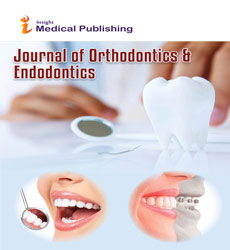Tooth Discoloration: Successful Aesthetic Improvement using a Novel Coating Material
Aiden Theo*
Department of Preventive Dentistry, Taif University, Taif, Saudi Arabia
Published Date: 2023-12-11DOI10.36648/2469-2980.9.6.100
Aiden Theo*
Department of Preventive Dentistry, Taif University, Taif, Saudi Arabia
- *Corresponding Author:
- Aiden Theo
Department of Preventive Dentistry,
Taif University, Taif,
Saudi Arabia,
Email: Theo@gmail.com
Received date: November 18, 2023, Manuscript No. IPJOE-24-18506; Editor assigned date: November 21, 2023, PreQC No. IPJOE-24-18506 (PQ); Reviewed date: December 04, 2023, QC No. IPJOE-24-18506; Revised date: December 11, 2023, Manuscript No. IPJOE-24-18506 (R); Published date: December 18, 2023, DOI: 10.36648/2469-2980.9.6.100
Citation: Theo A (2023) Tooth Discoloration: Successful Aesthetic Improvement using a Novel Coating Material. J Orthod Endod Vol.9 No.6:100.
Description
Crown staining of super durable teeth is brought about by injury, periapical sores of the deciduous teeth, drugs, and foundational infections. Crown staining has been treated with fading or crown rebuilding. In this review, we utilized a toothsurface covering material that contains elevated degrees of controlled-discharge fluoride that briefly further develops crown tone. We assessed the impact of the introduction on toothsurface qualities notwithstanding the covering specialist's shear bond strength, tooth-surface condition, and length of connection. We also asked patients how pleased they were with the change in color. The results showed that the primer had no negative effects on the enamel surface. The covering material itself showed a serious level of shear bond strength. We discovered that the coating material maintained long-term attachment under strict moisture prevention conditions and avoided occlusion zones based on clinical application shedding and fracturing observations. Treated youngsters and their folks were exceptionally happy with the variety improvement.
Crown Staining
These outcomes propose that this covering material is suitable for working on the shade of stained teeth during youth. Adults with this kind of crown discoloration can treat it with crown restoration techniques like bleaching, facing crowns, resin, and laminating veneers. Nonetheless, it is challenging to accomplish tasteful improvement in small kids during their time of development and advancement utilizing strategies expected for grown-ups. For example, practically all at-home and in-office dying methodology are not planned for small kids. Further, the utilization of irreversible crown rebuilding medicines that require tooth readiness isn't suitable in small kids, in light of the fact that the gingival edge level has not settled while the teeth are emitting or while the alveolar bone is as yet shaping. Consequently, an impermanent treatment for small kids with crown staining is required. The "tooth manicure" is one such method that makes use of materials that change the color of teeth in a single day. Nonetheless, the natural solvents utilized in nail trims are challenging to use inside the oral hole; accordingly, the impacts keep going for just 1-2 days, and keeping up with long haul variety improvement is troublesome. White CoatTM, a tooth-coating material intended solely for use in dental clinics, was developed in 2004. This material purposes a self-carving preliminary, and its grip toughness is around multi month.
Dental Materials
This item has better strength contrasted with over-thecounter tooth nail trims. Since then, materials with improved durability and good physical properties that don't harm the tooth have been developed. Surface response type preresponded glass ionomer filler has been created, which has actual strength and elevated degrees of controlled-discharge fluoride. The tooth-surface covering material contains this filler and is right now used to treat stained crowns. Dental materials utilizing S-PRG filler incorporate sealant materials, composite sap, orthodontic tar holding framework, dental replacement base gum, and root waterway sealer. Through the delivery and re-energize of fluoride and different particles, holes can be forestalled in the space of fix and adjoining teeth, and the attachment of plaque to the tooth surface can be smothered. This study explored the shear-grip strength and solidness of in the oral hole as well as the impact of its tooth-surface introduction on lacquer surface qualities. Last but not least, a survey of patients' satisfaction with color enhancement was carried out. Tasteful issues because of stained crowns are normal in pediatric clinical practice. Reasons for crown staining during the development of long-lasting teeth remember periodical injuries because of serious pits for deciduous teeth and polish arrangement issues because of tooth injury. Staining goes from white spots in gentle cases to substance misfortune with dim rosy earthy colored shading. Crowns can likewise be stained by the utilization of antibiotic medication anti-microbials or foundational infections during the tooth developmental period.
Open Access Journals
- Aquaculture & Veterinary Science
- Chemistry & Chemical Sciences
- Clinical Sciences
- Engineering
- General Science
- Genetics & Molecular Biology
- Health Care & Nursing
- Immunology & Microbiology
- Materials Science
- Mathematics & Physics
- Medical Sciences
- Neurology & Psychiatry
- Oncology & Cancer Science
- Pharmaceutical Sciences
